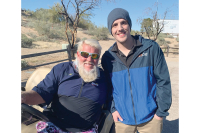Making the grade: Educator reinvents dropout prevention, but budget cuts jeopardize program
 Kyle Ledford spent years working with at-risk youth and high school dropouts in the Haywood school system. Saving kids was his calling, but it always felt like he was not playing with a full deck.
Kyle Ledford spent years working with at-risk youth and high school dropouts in the Haywood school system. Saving kids was his calling, but it always felt like he was not playing with a full deck.
SEE ALSO:
• Dropout program in jeopardy
• Caught in life’s crosshairs, students struggle not to dropout
• Trying to put a square peg in a round hole? Kyle Ledford’s your man
“The problems these kids were having could not be addressed in and of itself by a school. We couldn’t do anything about getting them a job or providing childcare or getting them housing and clothing,” Ledford said. “I can teach kids all day long, but I can’t do anything about housing and I can’t do anything about food stamps and I can’t do anything about transportation. The school system can’t solve a societal problem. It takes the community.”
Then it hit him one day: the idea to create an innovative dropout recovery program from whole cloth that included the missing pieces of the puzzle.
“We hopped in a truck and went to Raleigh for a dropout prevention meeting and came back with an idea for the community learning center,” Ledford said. “Here we have an academic program that is wrapped around a case management system, where every kid has an individual plan that may call for buying that kid a pair of shoes.”
The Haywood Community Learning Center builds a network of social services and creates a web of support around the student. For several years, the program has operated away from the public eye, quietly plugging away at its heroic and monumental work of transforming the lives and futures of would-be dropouts.
Related Items
A testament to its success, the dropout rate in Haywood County had dropped from 8 percent to just 1 percent since the program’s inception in 2007.
Once hidden in plain sight, the center has recently become known as one of the most innovative educational programs in the state, winning accolades as a model of what a successful dropout program looks like.
“In every community in this state there are folks who would line up to help. The agencies are already set up to help the kid with the need,” Ledford said. “The problem is we have never had a vehicle where a kid can come in and say ‘I need help’ and a plan is formed. Everybody in the building has access to a written plan, step-by-step, what these kids need to do and have done.”
Even more impressive, Ledford leverages the lion’s share of the operational budget for the program through grant funding, to the tune of more than $400,000 a year.
An alternative to the alternative
Alternative high schools are nothing new. But at the end of the day, alternative high schools are still schools, with mid-terms and tardies and all the peer pressure that creates an untenable environment for some students.
“It doesn’t offer enough of an alternative,” Ledford said.
After all, if traditional high school worked for them, they would still be there.
“The typical approach for our students didn’t work for whatever reason,” said Bill Covin, a social studies teacher at the school.
Students here don’t fit a mold, and no one tries to put them in one. The school day doesn’t have a start and stop time. Exams aren’t held on a schedule. Students work at their own pace, with teachers doubling as tutors to help them master subjects.
“For some students it takes longer, for some it’s quicker,” Covin said. “That flexibility is why we are successful.”
What matters is that they are showing up, applying themselves and learning.
“So you don’t come in until 9:30 in the morning, but you are here,” said Erman D’Alesandro, a teacher who works with exceptional students. “If we meet their needs to go to school any way they can, they can finish.”
The doors aren’t locked when a morning bell rings. You don’t need a hall pass to go to the drink machine. There’s even a school therapy dog.
“When a student needs some time out, I tell them ‘Go grab a pet,’” D’Alesandro said.
Since students here don’t move at the same pace, teachers don’t stand before the class holding forth on the elements in the periodic table or the Articles of the Constitution.
Instead, teachers serve more as tutors, meeting students wherever they are and helping them master subjects to earn credits. Students can largely come and go as they please during the week. They can pick their classrooms, pick their studies and pick their hours. Teachers are always on hand for guidance and oversight, but most learning is done online. The four classrooms in the center are filled with computer and laptop stations, some with a lounge-like set-up.
The school isn’t devoid of formal instruction, however. While the mornings are reserved for coursework, afternoons are filled with interdisciplinary and interactive sessions.
“We try to integrate reading and math skills in a hands-on environment,” Covin said.
Every Wednesday, for example, Covin leads an afternoon discussion group called “Hash tag trending now.” The course title cleverly disguises civics lessons, like how the electoral college and delegate counts work, or Civil War history when the Confederate Flag debate was raging.
On Thursday, Covin leads a weekly book discussion, currently centering on short stories about social plights in Southern Appalachia by well-known regional writer Ron Rash.
Students are required to partake in a certain number of afternoon learning labs for each course or credit that they’re working on.
“That’s like your lab and your practicum that enforces what they are learning,” Mark Ethridge said.
However, Covin sometimes has a hard time competing against the wow factor served up by Ethridge down the hall. His afternoon science labs include building robots, chemical analysis of water samples from the creek out back, planting and tending a school garden, and raising fish in the classroom.
Ethridge hosted an in-school technology competition where students got a $500 budget to design and build their concepts — which ranged from a backpack with a built-in solar panel for charging phones to a do-it-yourself home energy consumption auditing kit.
“It may or may not be as rigorous as a regular classroom, but they do a lot more than some kids I have taught who just sit there and do nothing and get a diploma,” Ethridge said. “I think the program is a model for all schools, not just a dropout school. Not everybody has the chance to do electronics and robotics and coding and grow a garden and do water monitoring.”
Karen McCracken, the office manager for the center, said students in the program are given flexibility but are expected to do the right thing.
“Giving them that little bit of trust translates into a positive response,” McCracken said.
And the students more often than not rise to the occasion when empowered.
Since the center lacks a cafeteria, churches in the community bring in food daily for lunch, but students take turns setting it out and cleaning up afterward. A student advisory club is consulted on school decisions — students even got to vote on the color of their tassels for the graduation ceremony.
These kids would never be candidates for student body president or prom queen at a traditional high school. But here, they’re given buy-in.
“The kids are engaged and take personal stock in what they do,” Ethridge said.
Making ends meet
Despite the grant funding Ledford rakes in, the center has to scrape by without the support of various state and federal programs found in traditional schools.
While nearly all the students come from low-income families and would typically qualify for free lunch and breakfast at a traditional school, the center gets no federal subsidies to feed them.
A network of community groups has rallied around the school to serve as its support network, including providing meals.
Every Thursday, volunteers from First Baptist Church in Waynesville slide into the school and head toward the break room that’s shared by teachers and students alike. They peek in the freezer for an inventory and show back up to restock the supply of microwave meals, frozen bagels and other staples to ensure the kids don’t go hungry.
First Baptist is one of a dozen churches that chip in to help keep the center stocked with food, including a MANNA food pantry students can take from.
“We normalize it and don’t make it weird for them. They can come in here and get food to stuff their backpacks with,” said Leslie Mowitt, the onsite coordinator for a 21st Century Community Learning grant that’s providing $1.4 million in funding over four years.
Food assistance isn’t the only resource being provided by community groups. From financial literacy to nutrition education, nonprofit and social service agencies funnel through the school on a regular basis to teach students life skills that are often just as critical as the high school education they are getting.
“The school in and of itself can’t fix these things. But we have shown what we can do when paired with what other folks do really well,” Ledford said.
This team of community partners is collectively nicknamed “The Village People.”
“They come from everywhere,” Mowitt said.
Jean Parris, the volunteer coordinator of the grassroots Drugs in Our Midst alliance, is one of the “village people” who serves as a guardian for the school. She’s often there during the week, both as moral support and to see what unmet needs the school has at the moment.
“I found out they didn’t have basketballs, even though there’s a basketball court right out here, so I bought them basketballs,” Parris said.
Only four part-time teachers — math, English, science and social studies — make the school tick. But their salaries are on the chopping block, jeopardizing the center’s ability to continue operating. The four teachers cost the school system only $91,000 a year.
Ethridge said it would be a loss for the entire community if the money isn’t found. He’s not worried about his own job, but about the kids who would be tossed overboard.
“They don’t have a voice and don’t have anyone to advocate for them,” Ethridge said.









